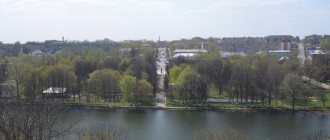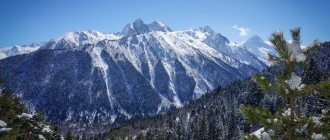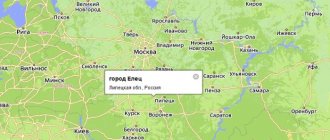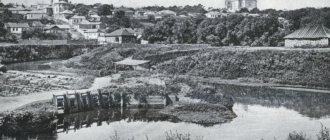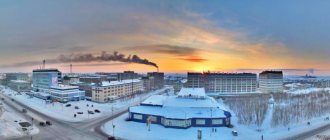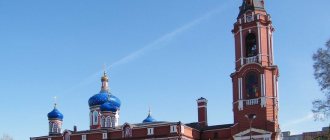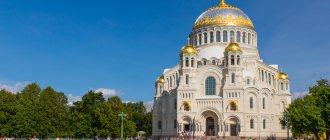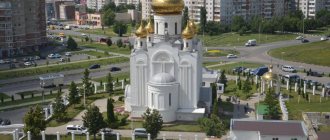Duderhof Heights
The Duderhof Heights are a group of three mountains: Mozhaiskaya (Voronya), Orekhovaya and Kirchhoff. Two of them are located in Krasnoye Selo.
Mozhayskaya Mountain (pictured below) is covered with forest. Between the trees there is a road and a ladder, both leading to the top. Having risen, you can relax pleasantly in the clearing. Take a cool selfie or just enjoy the panoramic view of Lake Duderhof, the city and its surroundings.
The mountain, like the railway station closest to it, is named in honor of A.F. Mozhaisky . At the end of the 19th century, he created the first Russian aircraft. Since he tested his invention in the Krasnoe Selo area, his name remained in the history of the city. During the war, Mozhaiskaya or “Voronya” mountain was an important strategic point; a few days after it was liberated by Soviet soldiers, the blockade of Leningrad was lifted. From this hill in clear weather there is a view of the southern regions of St. Petersburg.
One hundred meters from Voronya Mountain rises Mount Orekhovaya . The Nagorny Park will be located on it. There are information boards in the park with all the notable points on them. The top of Orekhovaya Mountain is the highest point in St. Petersburg, 176 meters. On the way to it, you can meet different species of birds and plants from the Red Book, unusual for the local latitudes. Almost at the top, an active source of spring water gushes from the depths.
Stories, routes and tips from tourists with photos
You can find out what other travelers recommend to see in Pushkin in 1 day in their reviews. Tourists share ready-made routes, unusual attractions and recommendations on how to productively organize their time in Pushkin. In the tourists' reports you will find tips on booking tickets to the city's museums, descriptions of tourist sites with realistic photographs.
- The story “Let's go to Tsarskoe Selo!” from Natalia Tarasova.
- The story “Parks of Tsarskoe Selo” from Elena Sarieva.
- The story “Cream Cake and the Surroundings” by Svetlana Turner.
- Photo album “Tsarskoe Selo. Winter" from Tatyana Egorova.
- Photo album “Catherine Palace (Tsarskoe Selo)” from Elena Sarieva.
All tourist reviews about trips to Pushkin on Turister.Ru
Tsarskoye Selo Lyceum Photo: kristina6306
Nameless lake
For many years, the Nameless Lake was recognized as the only one in St. Petersburg suitable for swimming. Due to ongoing cleanup work, swimming in it is now officially not recommended. Despite this, many people come during the season to relax on the well-maintained sandy beach. There is a cable wake park on one of the beaches of the lake. By the way, you don’t need to be able to swim to ride a wakeboard. Near the lake there is a volleyball court, playground and sports grounds for children.
Historical sites and museums
Museum of Russian Bridge Construction
The museum was opened in 1992 on the basis of the Central Museum of Railway Transport. The exhibits here include various drawings and models of bridges, rare paintings and photographs depicting bridge structures. Many of these structures are monuments of science and technology.
The museum is divided into six thematic halls, in each of which you can learn about the history of the creation of bridges, about the first crossings that appeared on the territory of our country, about interesting events related to domestic bridge construction, etc.
The pride and main treasure of this museum is the collection of miniature bridges: they are an exact copy of the structures of the 19th-20th centuries. At the exhibition you can see one of the most valuable miniatures, which was made back in 1833 - this is a copy of the ferry connecting Kamenny and Krestovsky Islands.
You can visit the museum only by appointment; you must take your passport with you.
Palace of Prince Mikhail Pavlovich
Address: Lenin Avenue, 114
The summer palace of Mikhail Pavlovich is made entirely of wood, and it is also considered the last surviving summer palace in Krasnoe Selo.
The house was built according to the design of the architect Dildin in the 1830s. By the way, the Kamennoostrovsky Palace, which is located in St. Petersburg, is also the work of Dildin.
Inside the prince's summer residence you can see a large number of paintings, many of them by Schwartz and Fendi. There is also an opportunity to look at how the life of the royals was organized.
Park "Krasnoe Selo" (Palace)
The park is located between Lenin, 1st May and St. Equalities. Today it is a landscaped area with beautiful ancient trees and alleys for walking. It has paths for walking and cycling, and areas with benches.
There is an open stage at the top of the park. It hosts city holidays and events. Over the course of its history, the park has changed 5 names and has changed a lot. At different times, it housed seven royal palaces; unfortunately, they have not survived to this day.
Where to stay
If you only have one day in Krasnodar, choose hotels in the city center - this way you can walk along beautiful Krasnaya in the evening and get to any attractions faster.
Hotel "Triumph", 4*. Conveniently located, guests praise the breakfast, free swimming pool for guests. I stayed here on my last trip, so I can highlight the pros and cons.
Among the shortcomings: terrible audibility - we had a room on the fifth floor, and the restaurant was on the sixth - at night you could hear furniture being moved there. I was not yet impressed by the cleaning of the rooms; there were not enough entry cards for all guests (it was overcrowded on New Year's Eve). Shampoos, a bathrobe and other necessities are provided for one person, so upon check-in you have to order additional sets for the remaining residents.
All this was outweighed by the advantages - very tasty breakfasts in a restaurant with panoramic views of the city and a spa, which is included in the price. I really miss their pool, hammam and Charcot's shower.
Hotel Red Royal, 4*. Good location, there is parking, a restaurant and an outdoor swimming pool (you will appreciate this in the summer).
Hotel Meliton, 3*. New hotel with cozy, clean rooms, parking and good breakfast. Separately, guests highlight the friendliness of the staff.
Krasnoselskaya Holy Trinity Church
Holy Trinity Church is the symbol of the city. A bright and elegant building in the early Baroque style, it stands out against the background of the utilitarian architecture of Krasnoye Selo. The church reminds of the distant past of the city. It is considered one of the oldest churches in St. Petersburg, as it was first built and consecrated in 1735.
The church is active, services are regularly held there, and it is open to the public. At the entrance there is a memorial plaque about the bookmark. For a long time the building was under reconstruction, but now you can get there and appreciate for yourself how spacious, intimate and cozy it is inside.
Location: Lenin Avenue - 108.
Religious sites
Krasnoselskaya Holy Trinity Church
Krasnoselskaya Holy Trinity Church is one of the oldest churches in St. Petersburg. Its history began in 1732. It was here that all members of the royal family from Catherine I to Nicholas II prayed.
The history of the church is quite complicated, since it was rebuilt several times, burned down and in 1944 suffered from military operations.
In 1938, its premises were intended for imprisonment of convicts; in the 1960s it was equipped as a House of Culture. And only in 1995 the consecration of the temple took place.
Hospital of the Community of Sisters of Charity of St. George
Address: Twenty-Fifth October Avenue, 105
The hospital is located near Krasnoe Selo. The building was built in the early 1900s according to the design of the architect Grigory Lyutsedarsky.
The community of sisters of mercy decided to build an oncology department for the poor on the territory of the hospital, which ultimately existed until 1914.
Unfortunately, it will not be possible to see what has been preserved inside, since at the moment there is a ski center for a youth sports school in the hospital building. But you can definitely look at the architecture of that time, because the building has practically not been reconstructed.
Temple of the Holy Blessed Grand Duke Alexander Nevsky
According to the design of engineer Vladimir Kolyanovsky, a wooden temple was built in honor of Alexander Nevsky in 1885.
Since during the Great Patriotic War Krasnoe Selo was located in the zone of German occupation, most of the churches were damaged or completely destroyed. And this one turned out to be the only one untouched by bullets and shells.
Church in the name of the Holy Archangel Michael
Address: Khvoyny village. (Krasnoe Selo), 13e Opening hours: Mon-Fri - 09:00-18:00; Sat-Sun - closed
In 1774, a wooden temple was built on the site of the modern church, which was soon destroyed. In 1910 it was rebuilt.
The church is still active to this day; various services are held there every day: memorial services, baptisms, all-night vigils and liturgies.
Temple-chapel of the Holy Blessed Queen Tamara
Address: Lermontov str., 30a Telephone:
The temple was built in the 1850s, and funeral services for the dead were usually held there. After the 1917 revolution, the chapel was closed and the building was used as a morgue.
In the 2000s, the temple-chapel was returned to its original function, but due to the fact that it had become quite dilapidated, it was decided to dismantle it and build a new one in this place - an exact copy. The temple was consecrated in 2008 and is currently operational.
Chapel of the Holy Righteous Simeon the God-Receiver
Back in 1800, according to one peasant Vasily Kislyakov, a fountain began to flow on the site of the current chapel and a lake was formed, in which the icon of Simeon the God-Receiver was found. In memory of this event, a small chapel was built near the place where the icon was found, which was soon destroyed and has not survived to this day.
Construction of the new chapel began in 2014, it was carried out by the Architectural Studio of G. P. Fomichev. The chapel has existed in its new appearance since 2015.
Triumphal Arch of Victory
The arch is a monument to the 70th anniversary of Victory in the Second World War. It was opened in May 2015. It depicts figures of warriors, wreaths, and the inscription “Glory to the conquering warriors.” The arch is lined with granite and is beautifully illuminated in the evening. The simple yet majestic architecture of the monument perfectly complements and decorates the main thoroughfare of the city.
Location: Lenin Avenue - 99.
Museum attractions
In addition to interesting museum objects related to Santa Claus and the New Year, Veliky Ustyug has interesting museums for history buffs that pay great attention to cultural traditions and folk crafts
Veliky Ustyug State Museum-Reserve
This museum, opened in 1910, tells in detail and interestingly about the history of Veliky Ustyug from the 12th to the 20th centuries. The four permanent exhibitions contain a variety of exhibits such as weapons, jewelry, household items, etc.
A separate exhibition is dedicated to Shemgorod carving and birch bark painting. The most interesting is the exhibition with silver jewelry and dishes made using the “northern niello” technique. A separate room is dedicated to the fine arts of the 19th-20th centuries, where you can see paintings by Shishkin, Aivazovsky, Vasnetsov and other famous Russian masters.
Those who want to learn more about the history, life and crafts of Veliky Ustyug should visit the following museums:
- Museum of Ancient Russian Art;
- showroom. Lots of beautiful silver and porcelain items. Here you can buy dishes, jewelry, interior items and various souvenirs;
- Repository;
- Ethnographical museum;
- Church of the Epiphany.
WWII monuments
Krasnoye Selo was occupied and suffered greatly during the Great Patriotic War, so the monuments to its heroes deserve special mention.
The memorial " Mass Grave of Soviet Soldiers " is located in the Palace Park. Since 2010, an eternal flame has been burning at the memorial of the year. Above the fire there is a monument to the unknown soldier, and next to it there are signs on which are engraved the names of soldiers who died in battle. The memorial is located in the area of the broken blockade ring. On memorable dates, residents bring wreaths and fresh flowers to him.
Prisoners of Nazism was opened in 2009 . The memorial was created in the form of a granite stele, inside which is the figure of a child and figurative figures of those who were not destined to return.
The “Grieving Mother” monument is dedicated to mothers who did not receive their sons back from the war. They never believed in the death of their sons and always waited, even when the war was long over.
Founding history
The history of Krasnoye Selo dates back to 1714. At this time, on the orders of Tsar Peter I, construction of the first Russian paper mill began on the Dudergofka River. To work at the factory, serfs were brought from the village of the same name, located in the Moscow region. This is probably where the name came from. Over time, the settlement grew:
- In 1733, construction of the Church of the Holy Trinity began. It still exists today.
- At the beginning of the 19th century, an additional chapel was built to the temple. Subsequently, all city buildings began to be grouped around the church.
- In 1765, large army exercises and parades began to be held here. Catherine II the Great took part in them.
- Since 1819, Krasnoye Selo became a summer army center. Exercises, training sessions and reviews of military units were constantly held here.
- In 1824, by decree of Emperor Alexander, the St. Petersburg garrison was assigned here for a summer stay. Gradually, a large military complex was formed in Krasnoe Selo.
In 1917, after the February coup, the Krasnoselsky Council was created. It consisted of Bolshevik soldiers and factory workers. With the beginning of the October Revolution, the 176th Infantry Regiment stationed in the settlement took the side of the Bolsheviks. The regiment was commanded by RVC Commissioner I. Levenson. Soon the reserve 171st regiment joined the rebels.
In 1919, the divisions of the White Guard General Yudenich were defeated in this place by the Red Army. The question of granting Krasnoye Selo city status was first raised back in 1918. An official decree on this was issued in 1925.
During the Great Patriotic War, fascist troops occupied the city. This happened in September 1941. Liberated by the joint efforts of the 42nd and 13th armies with the assistance of aviation. This happened in January 1944.
City today
In mid-September 2014, the city solemnly celebrated its tricentenary. The formation includes 2 more settlements - Khvoynoye and Mozhaisky. According to the Wikipedia portal, the population in 2021 is 58,110 people.
It may not be entirely obvious whether Krasnoe Selo belongs to St. Petersburg or the Leningrad region. The city is a municipal entity within the Northern capital.
There are 2 historical districts on the city map:
- Skachki - located between the Gorelovo overpass and the Gatchina railway.
- Mozhaisky-Dudergof - between the Dudergof lakes and Krasnoye Selo.
The St. Petersburg - Gatchina - Baltiysk railway line runs through the territory. There is a railway station on the eastern outskirts.
At the beginning of the 21st century, representatives of the imperial dynasty visited the city on an official visit. The delegation was headed by Maria Vladimirovka Romanova, the head of the Russian Imperial House in exile. She met with the head of the Krasnoselsk administration and also visited the main city attractions. In addition, Maria Vladimirovna attended the service in Trinity Church.
Veles stone size
It is noteworthy that the granite massif is strictly oriented to the cardinal points. The length of the northern wall is 8 m, the eastern wall is 4 m, the southern and western walls are 5 m each. The height of the stone is uneven. At the maximum point it reaches 3.5 m, at the minimum it does not exceed 2.5 m.
© Anton Kovalev
How deep into the ground the rest of the block goes is unknown. Once upon a time, a four-meter pole was lowered into a gap filled with water at the base of the stone on the southwestern side, but it did not reach the bottom (currently the gap is clogged with thin tree trunks).
Two oblique crosses (40x30 cm) are carved on the northern edge of the Veles stone. There are three options for their explanation. According to one, they were painted in the 16th century. Orthodox Christians. According to another, these are runic signs meaning sacrifice, which indicates pagan worship of the boulder in the 9th–10th centuries. There is also a version that the massif once served as a border between Russian and Swedish lands. Previously, it was customary to use noticeable stones as boundary signs, and to confirm this, a cross was applied to them.
In addition to them, on the top of the natural monument there are monograms in Latin letters (AJ, AB, JU). Perhaps these symbols are shortened meanings of Lutheran prayers and were left here in the 17th–19th centuries. By the way, the Finno-Ugric tribes called the boulder “Suurkivi”, which translated from Finnish means “Big Stone” and “Kirkkokivi” - “Church Stone”.
© Vadim Zhivotovsky
At the top of the Besov Stone there are protrusions that look like steps or seats, it is unknown who created them - by man or by nature itself. On one side, in the lower part, there is an arch-like recess, reminiscent of the entrance to a temple. Most likely, this was the reason for the name “Church”. The lower edges have chips, confirming the story that in the 16th century, during the period of struggle against pagan remnants, they tried to destroy the boulder - to split it into pieces using fire and water.
This event is also indicated by cracks on the block and numerous granite fragments scattered at the entrance to the forest. Perhaps an unsuccessful attempt to destroy the rune stone directed the struggle into an ideological direction, as a result of which names appeared in the context of “unclean” - “Demons”, “Devil”, “Sorcerer”. And “Velesov” is just one of the interpretations. And the forest, where the unusual boulder had stood for thousands of years, began to be considered dead. By the way, there are suggestions that the name of the city of Volosovo and the region itself are associated with the name of the deity Veles (Volos).
© Irina Mamontova
Legends
According to legend, the Besov Stone was once a church, but the parishioners and the priest were not particularly righteous, and God turned the temple into a granite block for their sins. Local residents say that at night or during a storm you can hear demonic whispers and laughter or church chants from under an unusual stone. And the place itself is “prodigal”; people can wander through the forest for hours, but still not find the boulder.
© Vladimir Slepukhin
By the way, around the granite massif, as befits a place of worship, four other small boulders can be found strictly in the cardinal directions (the western stone was moved), which indicates that rituals actually took place here, and the block itself was a pagan shrine.
Interesting information about the city
Veliky Ustyug is a calm, cozy town, located 450 km northeast of Vologda. In that place, 2 rivers (Sukhona and Yug) flow into the Northern Dvina. This moment is reflected in the city coat of arms.
The small town is always filled with tourists, especially in winter. It has become a focal point for family tourism since 1999, when it was declared the birthplace of Father Frost. It was awarded the title of a city-reserve.
The city arose simultaneously with Moscow. In ancient times, the settlement was called Gleden because it was located on a high mountain. It had a good view of all the surroundings. Today you can visit the area of the first settlement of Gledeni. On the banks of the Sukhona River stands the Trinity-Gledensky Monastery, preserved from those times. In summer, its inspection is available for tourists.
Trinity-Gledensky Monastery
But the place was subject to flooding from rivers and attacks by Chud tribes. Soon, residents began to move further south, and a new settlement was formed above the mouth of the Ust-Yug River. They called it Ustyug.
The first mention of Ustyug as a city appeared in 1207, when Vsevolod the Big Nest gave it to his son. References about the city were found in the chronicles:
- 1212 – foundation of the Archangel Michael Monastery;
- 1218 - its destruction by the Kama Bulgarians;
- end of the 14th century - entry into the Moscow Principality.
They began to call it great when Ivan IV included it in the list of oprichnina cities. Very few ancient Russian cities were awarded this title. It was awarded for the military skill of the squads and the skill of the masters.
In the 17th century it was one of the wealthiest cities in Rus'. About 10,000 people lived in it.
Veliky Ustyug gained the reputation of the main fur center of Rus'. The fairs were full of sable and squirrel skins. Twice a year, at the largest fairs, the city hosted merchants who came from other countries. They settled in the German settlement, located next to the St. John the Baptist Monastery.
Its role in trade with other countries especially increased during the reign of Catherine II after the introduction of a state monopoly on trade with China. The products of local artisans and bread were sent from the city, and fabrics, sugar, tea, and porcelain were imported.
However, mass trade did not flourish for long. Its decline began after:
- the opening of a trade route to Western Europe through the Baltic;
- Russia's access to the southern seas after the Russian-Turkish wars.
The economy finally weakens after the construction of railway lines that bypassed the city.
The history of Veliky Ustyug is closely intertwined with the names of many famous people. The first Ustyug pioneers (Dezhnev, Permsky, Popov, Khabarov, Atlasov, Navodchikov, Shilov) left their mark on the science of developing new lands. They boldly moved into the unknown reaches of Siberia, the lands lying near the Pacific Ocean. These people discovered new rivers, seas, and straits.



